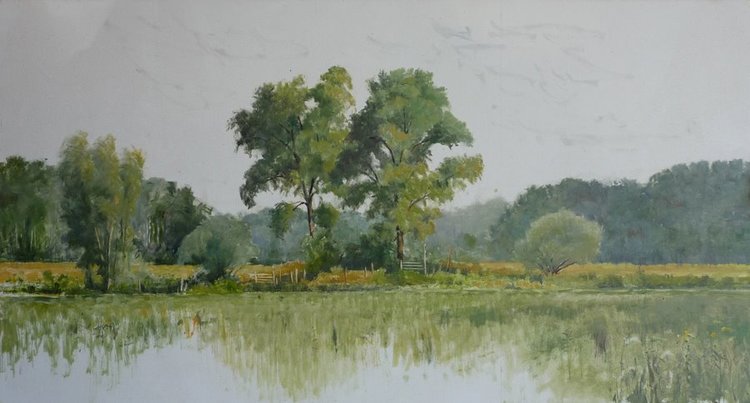Dreamlike, a summer pastoral landscape emerges through a haze of atmospheric light, as if conjured by our own vision. Brushy suggestions of clouds meander across an otherwise ambiguous and aleatory sky while we stand at the edge of a field fading into scattered optical unconscious. This oil painting by Jonathan Wilde, exhibited in his current show with Craig Clifford entitled Birds and Boundaries, as its title suggests, is in name, unfinished. However, as it hangs framed on a white gallery wall, its name is a bit of a paradox.

Unfinished Thoughts, Jonathan Wilde, 17.5" x 28"
Unfinished Thoughts belongs to a class of works that Art Historians call non finito, that is to say, intentionally left unfinished. Though the technique traditionally was used in sculpture during the Renaissance and Baroque periods, nineteenth-century artists during the Romantic era began applying the style to their paintings. Many scholars, myself included, argue that this quality signals the beginning of Modernism as we know it.
Artists, especially painters, have historically struggled with the finishing their works. While Jacques-Louise David and Paul Cézanne embraced non finito works, deliberately leaving large areas unfinished or blank entirely, others, such as Claude Monet and Joseph Mallord William Turner, never felt their works were finished and rather continued to develop over their careers, returning again and again to paintings to make small additions here and there. These works represent the problem of infinite of possibility, finite time, and the possibility of over working (of which I am myself, a watercolor artist, acutely aware). Camille Pissarro even famously proclaimed that “[t]o finish a work, is to kill it.”
Non finito works are, at their core, experimental; we can see the artist’s process as he works out visual challenges— his thoughts leaving their mark across the canvas. I believe that works like Unfinished Thoughts hold a particular power as they insist the viewer actively participate; our inherently creative minds make sense of the “partial” image by filling incomplete portions— we too become artists in our own right. Looking becomes making.
